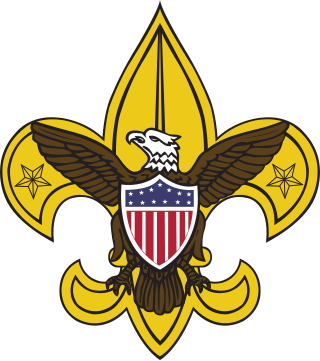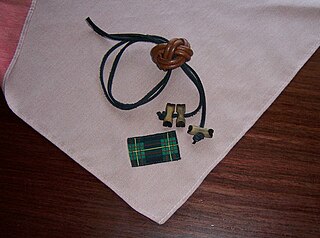
The Boy Scouts of America is one of the largest scouting organizations and one of the largest youth organizations in the United States, with over 1 million youth, including 176,000 female participants. The BSA was founded in 1910; about 130 million Americans have participated in its programs, which are served by 477,000 adult volunteers. BSA became a founding member organization of the World Organization of the Scout Movement in 1922.

Eagle Scout is the highest rank attainable in the Scouts BSA program by the Boy Scouts of America (BSA). Since its inception in 1911, only four percent of Scouts have earned this rank after a lengthy review process. The Eagle Scout rank has been earned by over 2.5 million youth.

Advancement and recognition in the Boy Scouts of America is a tradition dating from the inception of the Scouting movement. A fundamental purpose of advancement is the self-confidence a young man or woman acquires from his participation in Scouting. Advancement is one of the methods used in the "Aims and Methods of Scouting"– character development, citizenship training and personal fitness.

Cub Scouting is part of the Scouting program of Scouting America, formerly known as Boy Scouts of America (BSA), available to boys and girls from kindergarten through fifth grade, or 5 to 10 years of age and their families. Its membership is the largest of the five main BSA divisions. Cub Scouting is part of the worldwide Scouting movement and aims to promote character development, citizenship training, personal fitness, and leadership.

Venturing is a core program of the Boy Scouts of America for young men and women ages 14 through 20. It is one of the Boy Scouts' three programs for older youth, which also include Sea Scouts and Exploring. The purpose of Venturing is to provide a positive environment where youth members, called Venturers, can lead the adventure, take on new leadership roles, and mature into responsible adults.

Varsity Scouting was a program of the Boy Scouts of America (BSA). It was an alternative available to boys ages fourteen to eighteen until the end of 2017. It used the basic Boy Scouting program and added high adventure, sporting, and other elements that were more appealing to older youth to accomplish the aims of character development, citizenship training, and personal fitness. Varsity Scouts were organized into teams; separate chartered units from a Boy Scout troop.

Firecrafter is a service organization within the Boy Scouts of America. Formed in 1920, the Firecrafter Organization mainly operates within the Crossroads of America Council, Indiana, but has been known to exist in other areas including Illinois and Texas.

The Boy Scouts of America (BSA) use uniforms and insignia to give a Scout visibility and create a level of identity within both the unit and the community. The uniform is used to promote equality while showing individual achievement. While all uniforms are similar in basic design, they do vary in color and detail to identify the different membership divisions of Cub Scouting, Scouts BSA and Venturing. Many people collect BSA insignia such as camporee and jamboree emblems, council shoulder strips and historical badges.
The history of merit badges in the Boy Scouts of America (BSA) has been tracked by categorizing them into a series of merit badge types. In addition to the Boy Scouts of America, many other Scouting and Scouting-like organizations around the world, such as Pathfinders, Baden-Powell Scouts and Royal Rangers, issue merit badges or their equivalent; though they are sometimes called honors or proficiency badges. Other organizations, such as fire brigades, issue badges or awards that they refer to as merit badges, but that is in some respects different from the badges awarded by the BSA.

William Hillcourt, known within the Scouting movement as "Green Bar Bill", was an influential leader in the Boy Scouts of America (BSA) organization from 1927 to 1992. Hillcourt was a prolific writer and teacher in the areas of woodcraft, troop and patrol structure, and training; his written works include three editions of the BSA's official Boy Scout Handbook, with over 12.6 million copies printed, other Scouting-related books and numerous magazine articles. Hillcourt developed and promoted the American adaptation of the Wood Badge adult Scout leader training program.

Scouts BSA is the flagship program and membership level of the Boy Scouts of America (BSA) for coeducational young people between the ages of typically 11 and 17. It provides youth training in character, citizenship, personal fitness, and leadership, and aims to develop the skills necessary to become successful adults.

First Class Scout is a rank in the Boy Scouts of America, the rank above Second Class and below Star Scout. It is the highest of the lower four ranks in Scouting, and is the minimum rank that need be attained for entry into the Order of the Arrow.

The Boy Scouts of America (BSA) was inspired by and modeled on The Boy Scouts Association, established by Robert Baden-Powell in Britain in 1908. In the early 1900s, several youth organizations were active, and many became part of the BSA.
The Eagle Scout Service Project, or simply Eagle Project, is the opportunity for a Scout, or qualified Venturer or Sea Scout in the Boy Scouts of America (B.S.A.) to demonstrate leadership of others while performing a project for the benefit of their community. This is the culmination of the Scout's leadership training, and it requires a significant effort on his or her part. The project must benefit an organization other than the B.S.A., and it cannot be performed for an individual or a business or be commercial in nature. Completing an Eagle Project is a requirement in order for Scouts to attain the Eagle Scout rank.
The rank insignia system of the Indonesian Scouting movement Gerakan Pramuka Indonesia is by and large militarized in traditions and outfit.

Wood Badge in the United States is an advanced level leadership training available to adult Scout leaders. The first Wood Badge course was presented in England by the founder of Scouting, Baden-Powell, and he introduced the program into the United States during a visit in 1936. The first course was held at the Mortimer L. Schiff Scout Reservation, but Americans did not fully adopt Wood Badge until 1948. The National BSA Council staff provided direct leadership to the program through 1958, when the increased demand encouraged them to permit local councils to deliver the training.
The advancement program for the Scout Association of Japan is symbolized by the earning of several rank badges.
Orienteering is a longtime component of Scouting programs such as the Boy Scouts of America and other Scouting groups. The BSA first class rank requires that scouts complete a one-mile orienteering course by using a map and compass. The Scout must also measure the height of objects, such as trees, using simple trigonometry. Although some troops tend to emphasize the use of compass bearings and pacing, orienteering actually involves a variety of skills, including map reading and route solving.
Leadership training in the Boy Scouts of America includes training on how to administer the Scouting program, outdoor skills training for adults and youth, and leadership development courses for adults and youth. Some of these courses like Youth Protection Training are mandatory. Most of the courses are offered by the local council, while a few are hosted at the national level, currently at Philmont Training Center in New Mexico. They are available to members of all of the Boy Scout programs, including Cub Scouts, Boy Scouts, Explorer Posts, and Venturing Crews.

In the Boy Scouts of America, a Scout leader refers to the trained leaders of a Scout unit. Adult leaders are generally referred to as "Scouters," and the youth leaders are referred to by their position within a unit. In all Scouting units above the Cub Scout pack and units serving adolescent Scouts, leadership of the unit comprises both adult leaders (Scouters) and youth leaders (Scouts). This is a key part of the Aims and Methods of Scouting. In order to learn leadership, the youth must actually serve in leadership roles.














